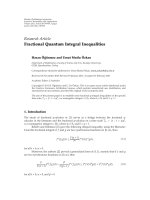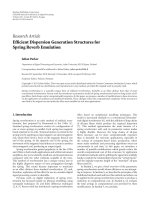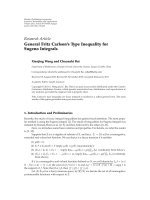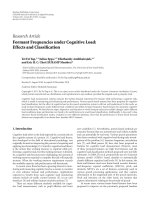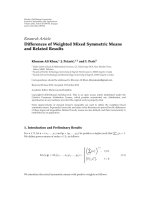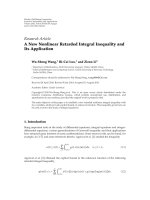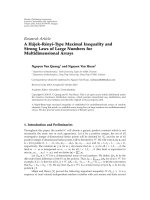báo cáo hóa học:" Research Article Notes on Interpolation Inequalities Jiu-Gang Dong1 and Ti-Jun Xiao2" ppt
Bạn đang xem bản rút gọn của tài liệu. Xem và tải ngay bản đầy đủ của tài liệu tại đây (460.78 KB, 6 trang )
Hindawi Publishing Corporation
Advances in Difference Equations
Volume 2011, Article ID 913403, 6 pages
doi:10.1155/2011/913403
Research Article
Notes on Interpolation Inequalities
Jiu-Gang Dong
1
and Ti-Jun Xiao
2
1
Department of Mathematics, University of Science and Technology of China, Hefei 230026, China
2
Shanghai Key Laboratory for Contemporary Applied Mathematics, School of Mathematical Sciences,
Fudan University, Shanghai 200433, China
Correspondence should be addressed to Ti-Jun Xiao,
Received 3 October 2010; Accepted 16 November 2010
Academic Editor: Toka Diagana
Copyright q 2011 J G. Dong and T J. Xiao. This is an open access article distributed under
the Creative Commons Attribution License, which permits unrestricted use, distribution, and
reproduction in any medium, provided the original work is properly cited.
An easy proof of the John-Nirenberg inequality is provided by merely using the Calder
´
on-
Zygmund decomposition. Moreover, an interpolation inequality is presented with the help of the
John-Nirenberg inequality.
1. Introduction
It is well known that various interpolation inequalities play an important role in the study of
operational equations, partial differential equations, and variation problems see, e.g., 1–6.
So, it is an issue worthy of deep investigation.
Let Q
0
be either R
n
or a fixed cube in R
n
. For f ∈ L
1
loc
Q
0
, write
f
BMO
: sup
Q⊂Q
0
1
|
Q
|
Q
f − f
Q
dx, 1.1
where the supremum is taken over all cubes Q ⊂ Q
0
and f
Q
:1/|Q|
Q
fdx.
Recall that BMOQ
0
is the set consisting of all locally integrable functions on Q
0
such that f
BMO
< ∞, which is a Banach space endowed with the norm ·
BMO
.Itisclear
that any bounded function on Q
0
is in BMOQ
0
, but the converse is not true. On the other
hand, the BMO space is regarded as a natural substitute for L
∞
in many studies. One of the
important features of the space is the John-Nirenberg inequality. There are several versions
of its proof; see, for example, 2, 7–9. Stimulated by these works, we give, in this paper, an
easy proof of the John-Nirenberg inequality by using the Calder
´
on-Zygmund decomposition
only. Moreover, with the help of this inequality, an interpolation inequality is showed for L
p
and BMO norms.
2 Advances in Difference Equations
2. Results and Proofs
Lemma 2.1 John-Nirenberg inequality. If f ∈ BMOQ
0
, then there exist positive constants c
1
,
c
2
such that, for each cube Q ⊂ Q
0
,
x ∈ Q :
f
x
− f
Q
>t
≤ c
1
exp
−
c
2
f
BMO
t
|
Q
|
,t>0. 2.1
Proof. Without loss of generality, we can and do assume that f
BMO
1.
For each t>0, let Ft denote the least number for which we have
x ∈ Q :
f
x
− f
Q
>t
≤ F
t
|
Q
|
, 2.2
for any cube Q ⊂ Q
0
.ItiseasytoseethatFt ≤ 1t>0 and Ft is decreasing.
Fix a cube Q ⊂ Q
0
. Applying the Calder
´
on-Zygmund decomposition cf., e.g., 2, 9
to |fx − f
Q
| on Q,with2
n
as the separating number, we get a sequence of disjoint cubes
{Q
j
} and E such that
Q
⎛
⎝
j
Q
j
⎞
⎠
∪ E, 2.3
f
x
− f
Q
≤ 2
n
, for a.e.x∈ E, 2.4
2
n
<
1
Q
j
Q
j
f − f
Q
dx ≤ 4
n
.
2.5
Using 2.5, we have
j
Q
j
<
1
2
n
|
Q
|
. 2.6
From 2.3, 2.4,and2.6, we deduce that for t>4
n
,
x ∈ Q :
f
x
− f
Q
>t
j
x ∈ Q
j
:
f
x
− f
Q
>t
≤
j
x ∈ Q
j
:
f
x
− f
Q
>t− 4
n
j
Q
j
1
Q
j
x ∈ Q
j
:
f
x
− f
Q
>t− 4
n
≤
1
2
n
F
t − 4
n
|
Q
|
.
2.7
Advances in Difference Equations 3
This yields that
F
t
≤
1
2
n
F
t − 4
n
,t>4
n
. 2.8
Let γ t − 14
−n
t>4
n
, μ 1 γ4
n
. Then 0 <μ≤ t. By iterating, we get
F
t
≤ F
μ
F
1 γ4
n
≤ 2
−nγ
≤ 2
−nt−14
−n
−1
2
n14
−n
exp
−
log 2
n4
−n
t
,t>4
n
.
2.9
Thus, letting
c
1
2
n14
−n
,c
2
log 2
n4
−n
2.10
gives that
F
t
≤ c
1
e
−c
2
t
,t>0, 2.11
since
F
t
≤ 1 ≤ c
1
e
−c
2
t
, 0 <t≤ 4
n
. 2.12
This completes the proof.
Remark 2.2. 1 As we have seen, the recursive estimation 2.8 justifies the desired
exponential decay of Ft.
2 There exists a gap in the proof of the John-Nirenberg inequality given in 2.
Actually, for a decreasing function Gt : 0, ∞ → 0, 1, the following estimate:
G
2 · 2
n
α
≤
1
α
G
2
n
α
,α>1 2.13
does not generally imply such a property, that is, the existence of constants c
1
,c
2
> 0 such
that
G
t
≤ c
1
e
−c
2
t
,t>0. 2.14
We present the following function as a counter example:
G
t
exp
−
log
5
3
−1
log
2
t 1
,t>0. 2.15
4 Advances in Difference Equations
In fact, it is easy to see that there are no constants c
1
,c
2
> 0 such that 2.14 holds. On the
other hand, we have
G
t
G
t
−
log
5
3
−1
2
log
t 1
t 1
,t>0. 2.16
Integrating both sides of the above equation from 2
n
α to 2 · 2
n
α,weobtain
G
2 · 2
n
α
exp
−2
log
5
3
−1
2·2
n
α
2
n
α
log
t 1
t 1
dt
G
2
n
α
exp
−
log
5
3
−1
log
2
2 · 2
n
α 1
− log
2
2
n
α 1
G
2
n
α
exp
−
log
5
3
−1
log
2 · 2
n
α 1
2
n
α 1
· log
2 · 2
n
α 1
2
n
α 1
G
2
n
α
≤ exp
− log
2 · 2
n
α 1
2
n
α 1
G
2
n
α
1
2 · 2
n
α 1
2
n
α 1
G
2
n
α
≤
1
α
G
2
n
α
,
2.17
where the fact that
2 · 2
n
α 1
2
n
α 1
>
5
3
α>1
2.18
is used to get the first inequality above. This means that
G
2 · 2
n
α
≤
1
α
G
2
n
α
,α>1. 2.19
Next, we make use of the John-Nirenberg inequality to obtain an interpolation
inequality for L
p
and BMO norms.
Theorem 2.3. Suppose that 1 ≤ p<r<∞ and f ∈ L
p
Q
0
∩ BMOQ
0
. Then we have
f
L
r
≤
const
f
p/r
L
p
f
1−p/r
BMO
. 2.20
Advances in Difference Equations 5
Proof. If f
BMO
0, the proof is trivial; so we assume that f
BMO
/
0. In view of the
Calder
´
on-Zygmund decomposition theorem, there exists a sequence of disjoint cubes {Q
j
}
and E such that
Q
0
⎛
⎝
j
Q
j
⎞
⎠
∪ E, 2.21
fx
p
≤
f
p
BMO
for a.e.x∈ E, 2.22
f
p
BMO
<
1
Q
j
Q
j
f
x
p
dx ≤ 2
n
f
p
BMO
.
2.23
From 2.23,weget
j
Q
j
<
1
f
p
BMO
Q
0
fx
p
dx
f
p
L
p
f
p
BMO
,
f
Q
j
1
Q
j
Q
j
f
x
dx ≤
1
Q
j
Q
j
fx
p
dx
1/p
≤ 2
n/p
f
BMO
.
2.24
Using 2.21–2.24, together with Lemma 2.1, yields that, for λ>2
n/p
f
BMO
,
x ∈ Q
0
:
f
x
>λ
j
x ∈ Q
j
:
f
x
>λ
≤
j
x ∈ Q
j
:
f
x
− f
Q
j
>λ−
f
Q
j
≤
j
Q
j
1
Q
j
x ∈ Q
j
:
f
x
− f
Q
j
>λ− 2
n/p
f
BMO
≤
j
c
1
exp
−
c
2
f
BMO
λ − 2
n/p
f
BMO
Q
j
≤ c
1
exp
−
c
2
f
BMO
λ − 2
n/p
f
BMO
f
p
L
p
f
p
BMO
.
2.25
6 Advances in Difference Equations
From 2.25,weobtain
f
r
L
r
r
∞
0
λ
r−1
x ∈ Q
0
:
f
x
>λ
dλ
r
2
n/p
f
BMO
0
λ
r−1
x ∈ Q
0
:
f
x
>λ
dλ
r
∞
2
n/p
f
BMO
λ
r−1
x ∈ Q
0
:
f
x
>λ
dλ
≤ r
2
n/p
f
BMO
0
λ
r−1
f
p
L
p
λ
p
dλ
r
∞
2
n/p
f
BMO
λ
r−1
c
1
exp
−
c
2
f
BMO
λ − 2
n/p
f
BMO
f
f
p
L
p
f
p
BMO
dλ
r
r − p
2
n/pr−p
f
r−p
BMO
f
p
L
p
rc
1
c
2
2
n/pr−1
f
r−p
BMO
f
p
L
p
≤
const
f
r−p
BMO
f
p
L
p
.
2.26
Hence, the proof is complete.
Acknowledgments
The authors would like to thank the referees for helpful comments and suggestions. The work
was supported partly by the NSF of China 11071042 and the Research Fund for Shanghai
Key Laboratory for Contemporary Applied Mathematics 08DZ2271900.
References
1 D. Gilbarg and N. S. Trudinger, Elliptic Partial Differential Equations of Second Order, Classics in
Mathematics, Springer, Berlin, Germany, 2001.
2 Y. S. H an, Mordern Harmonic Analysis Methods and Applications, Science Press, Beijing, China, 1997.
3 H. Triebel, Interpolation Theory, Function Spaces, Differential Operators, vol. 18 of North-Holland
Mathematical Library, North-Holland, Amsterdam, The Netherlands, 1978.
4 T J. Xiao and J. Liang, The Cauchy Problem for Higher-Order Abstract Differential Equations, vol. 1701 of
Lecture Notes in Mathematics, Springer, Berlin, Germany, 1998.
5 T J. Xiao and J. Liang, “Complete second order differential equations in Banach spaces with dynamic
boundary conditions,” Journal of Differential Equations, vol. 200, no. 1, pp. 105–136, 2004.
6 T J. Xiao and J. Liang, “Second order parabolic equations in Banach spaces with dynamic boundary
conditions,” Transactions of the American Mathematical Society, vol. 356, no. 12, pp. 4787–4809, 2004.
7 C. George, Exercises in Integration, Springer, New York, NY, USA, 1984.
8 F. John and L. Nirenberg, “On functions of bounded mean oscillation,” Communications on Pure and
Applied Mathematics, vol. 14, pp. 415–426, 1961.
9 Elias M. Stein, Harmonic Analysis: Real-Variable Methods, Orthogonality, and Oscillatory Integrals, vol. 43
of Princeton Mathematical Series, Princeton University Press, Princeton, NJ, NY, USA, 1993.
